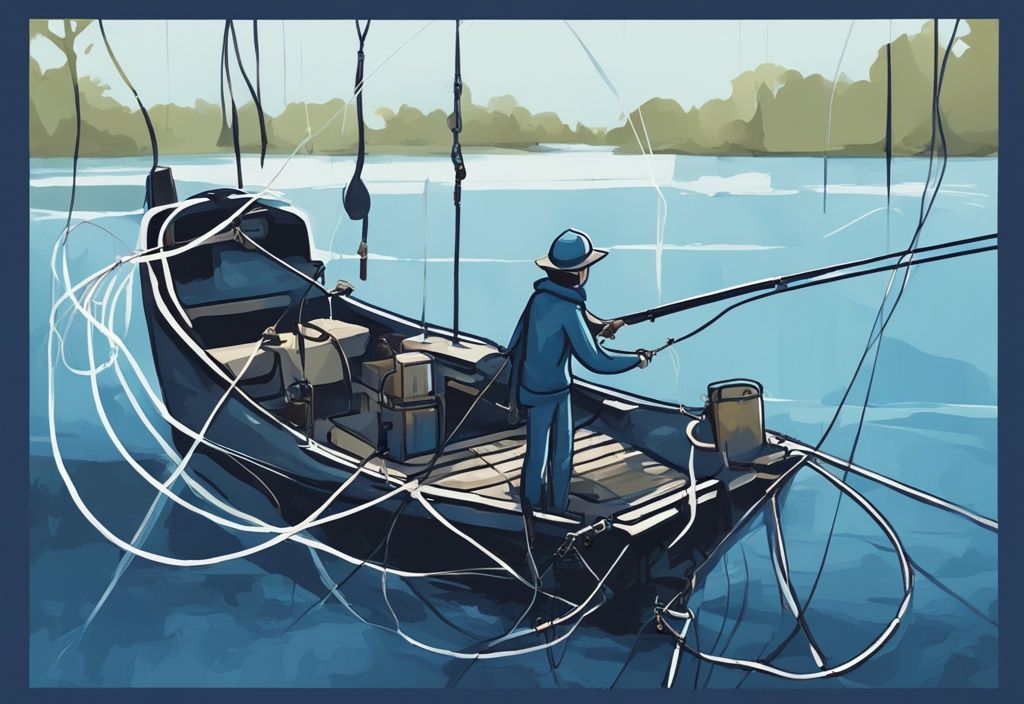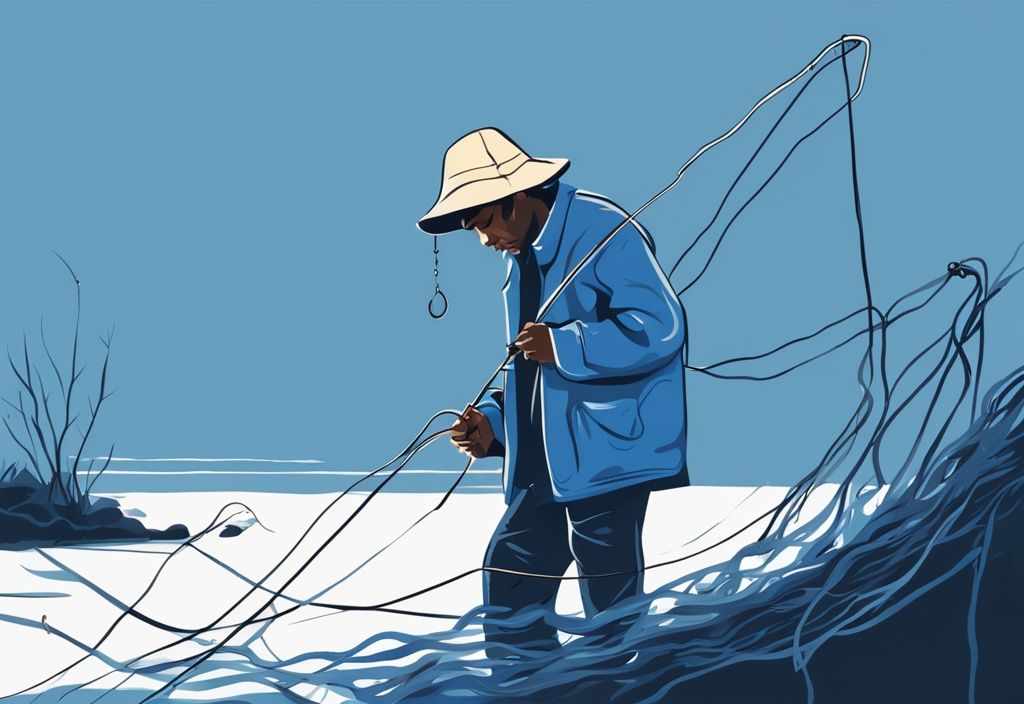Ever realized how a tangled fishing line can dampen an otherwise perfect day out on the water? If you’re shaking your head in agreement, then be rest assured, you’re not the only one dealing with this nuisance. Having weathered the frustration of such incidents in my twenty years of fishing, I decided to unravel the mystery behind tangled lines.
So, why does your fishing line keep getting tangled? There’s a confounding maze of factors at play – fickle wind conditions, the knots you use, or even the way you store your gear. But don’t fret! With the right insight into the root causes and effective prevention methods, untangling lines could turn into a thing of the past.
In this guide, I will share the tips and tricks that I’ve learned over the years to avoid these pesky snags and knots. It doesn’t matter if you’re a greenhorn or an old hand at fishing, these strategies will ensure smoother lines and a more rewarding day of fishing. Dive in and enjoy a tangle-free fishing experience from here on out.
Common Causes of Fishing Line Tangles
Wind Factors Affecting Fishing Line
Fishing enthusiasts often wonder, “why does my fishing line keep getting tangled,” and one common culprit is wind. Casting into the wind can create “wind knots,” those frustrating tangles that disrupt a smooth fishing experience. These knots occur due to speed differences between the reel and the rod tip.
To mitigate this issue, try casting with the wind at your back. Alternatively, casting low to the water surface can also help minimize wind knots by reducing the wind’s impact on the line.
How Overfilling the Spool Leads to Tangles
Another frequent answer to “why does my fishing line keep getting tangled” is overfilling the spool. When the spool is filled beyond its capacity, it leads to uneven unwinding and inevitable tangles.
Ensure you follow the manufacturer’s guidelines for the maximum line amount, leaving a slight gap between the line and the spool’s edge. Overfilling can cause coils to fall off, resulting in line overlap and tangling, creating a less enjoyable fishing experience.
Incorrect Spooling Techniques and Fishing Line Tangles
Incorrect spooling techniques often explain why your fishing line keeps getting tangled. Using improper methods when spooling can result in a poorly managed line, causing tangles. Always adhere to the manufacturer’s recommendations, keep the reel clean, and maintain consistent tension while spooling.
Incorrectly winding the line, such as in the wrong direction, can similarly lead to frustrating tangles, thus impairing your fishing efficiency.
The Role of Fishing Line Memory in Tangles
Fishing line memory is another key factor in understanding why your fishing line keeps getting tangled. Line memory issues occur when the line “remembers” the spool’s shape, becoming curly and coiled.
Lines with minimal memory, such as braided lines, are preferred to avoid this problem. Monofilament lines are more prone to memory issues, especially when old and coiled over time, making tangles more likely.
Tangled Lines: Could It Be Due to Improper Storage?
Many anglers overlook storage, a significant reason why fishing lines keep getting tangled. Exposure to direct sunlight or high temperatures exacerbates line memory problems.
Storing fishing lines in cool, shaded areas and periodically stretching the line can prevent coils. Additionally, regular cleaning and maintenance of the fishing line and reel are crucial in avoiding tangled lines due to dirt and grime buildup.
How Slack in the Fishing Line Contributes to Tangles
Slack in the fishing line is a common reason why fishing lines keep getting tangled. Too much slack while casting or reeling in can lead to unwelcome tangles.
Maintaining tension on the line is essential, whether by adjusting reel settings or using your fingers. Loose or slack lines on the spool create loose coils, greatly increasing the risk of tangles, which can disrupt your fishing rhythm.

Effective Measures for Preventing Tangles in Your Fishing Line
Struggling with tangled fishing lines is a common frustration for anglers, often stemming from not following manufacturer guidelines. These tips ensure proper spooling techniques and the recommended amount of fishing line, which is key to avoiding those pesky tangles.
The Importance of Following Manufacturer Guidelines
Understanding why does my fishing line keep getting tangled often starts with following manufacturer guidelines. These instructions ensure you’re using the correct spooling techniques and adhering to the recommended amount of fishing line. Overfilling or underfilling the spool can lead to uneven line distribution, resulting in tangles. Manufacturers also provide guidelines on matching the line weight with lures and reels to enhance performance and reduce tangling risks. Specific instructions are available to help prevent line twists, ensuring a smoother fishing experience.
Why Maintaining Proper Line Tension Can Prevent Tangles
One significant reason why does my fishing line keep getting tangled is improper line tension. Using too little tension when packing your spool can lead to loosely packed lines, causing bird’s nests and tangles. To prevent this, maintaining consistent tension while spooling and casting is crucial. This practice ensures that the fishing line is tightly packed, minimizing the formation of loose coils. Regularly adjusting your reel settings to maintain proper tension is another proactive measure to avoid unwanted tangles, allowing for smoother line management.
The Necessity of Regular Line Checks and Maintenance
Regular maintenance is key to preventing line tangles. Periodically inspecting fishing lines for any signs of wear and tear is essential, as damaged lines are more prone to tangles. Cleaning both the fishing line and reel can remove dirt and grime buildup, which often causes line sticking. Stretching the line periodically helps in maintaining its integrity and smoothness. Through regular checks and maintenance, you can ensure that the fishing line is in optimal condition, addressing the core issue of why does my fishing line keep getting tangled.
How Using the Correct Fishing Gear Reduces Tangles
Using incorrect fishing gear is a common reason why does my fishing line keep getting tangled. The size of the line is critical; a line too heavy or too light for your reel can cause improper functioning and tangles. Additionally, using the correct type of gear—such as pairing a spinning reel with a spinning rod—facilitates smoother operation and reduces the chances of line twisting and tangling. Ensuring that all your fishing equipment is compatible and well-matched is a proactive step towards a tangle-free fishing experience.
Choosing the Right Fishing Line to Avoid Tangles
The type of fishing line you choose can significantly impact why does my fishing line keep getting tangled. Braided fishing lines are often favored for their thinner diameter, zero stretch, and minimal line memory, making them less prone to tangles. Monofilament lines, while popular, are more susceptible to twists and knots compared to braided or fluorocarbon lines. Choosing the right line suited for your specific fishing environment and gear setup is crucial in minimizing the occurrence of tangles and ensuring a smoother fishing experience.
Improve Your Fishing Experience with Proper Casting Techniques
Improper casting techniques are another common reason why does my fishing line keep getting tangled. Casting with excessive force can cause inconsistencies in line speed, leading to tangles. By pointing the rod straight out after the cast, you can reduce friction, aiding in a smoother line release. Another tip is to avoid “rainbow casting” or casting high into the air, as this can slow down the line and increase the chance of tangles. Implementing proper casting techniques ensures a more seamless and enjoyable fishing experience.

Pro Tips for Handling and Storing Fishing Lines to Prevent Tangles
Let’s dive into some essential practices for handling and storing your fishing lines to keep those pesky tangles at bay.
How Proper Spool Tightening Can Save Your Line from Tangles
Ever wonder, “why does my fishing line keep getting tangled?” Proper spool tightening is a game-changer in addressing this frustration. A tightly wound spool ensures your line stays snug, minimizing those annoying loose coils that inevitably turn into tangles. When spooling your line, take your time—wind it evenly and uniformly across the spool. Avoid reeling while the drag is engaged; it can lead to loose spooling and, you guessed it, tangles. Tighten your spool correctly, and you’ll be well on your way to smooth sailing—or fishing.
Keeping Your Fishing Line Tangle-Free: It’s All About Storage
Effective storage practices are your best friend when it comes to maintaining a tangle-free fishing line. Store your lines in cool, shaded areas to dodge the memory issues that come with direct sunlight and high temperatures. Regularly inspect and clean your lines to prevent dirt and grime buildup, which can also lead to tangling. Proper spooling storage practices are crucial for preserving line integrity. Want to minimize those maddening tangles? Paying attention to how you store your line is an excellent place to start.
‘Give it a Stretch’: How Periodic Stretching Prevents Line Tangles
Believe it or not, periodic stretching of your fishing line can do wonders in preventing tangles. By stretching your line, you maintain its smoothness and reduce the formation of coils that cause tangling. This practice helps to diminish line memory, ensuring better performance and a longer lifespan for your fishing line. Regularly stretching your line keeps it well-conditioned and prevents those unwelcome tangles. Make this a routine part of your line maintenance, and you’ll find yourself asking, “why does my fishing line keep getting tangled?” far less often.
Troubleshooting Common Fishing Line Problems
The Best Ways to Handle Line Twist
Wondering why does my fishing line keep getting tangled? One major culprit is line twists. Imagine casting your line, only to find it looping back on itself. Frustrating, right? This often happens due to improper reeling techniques or the use of rotating lures like in-line spinners. When you reel against the drag, it can cause unwanted twists. To battle this, try using a barrel swivel. This handy tool can stop twists from marching down to your mainline. Also, match your reel and line setup closely, and reel in line with the lure’s rotation. These small adjustments can make a big difference, paving the way for a smoother, tangle-free fishing adventure.
How to Overcome the Wind Knots Problem
Wind knots! As if battling the wind isn’t enough, these sneaky knots add to the frustration of tangled lines. They often sneak in when you’re casting against the wind. How do you beat them? Start by casting low to the water’s surface to dodge wind interference. Using rods with firmer tips can also cut down on line bounce, which is a key factor in wind knots. A line lubricant can be your best friend here, easing friction and making any knots that do form easier to untangle. These strategies tackle the persistent issue of why does my fishing line keep getting tangled in windy conditions and keep you casting smoothly.
Guide on Fixing Uneven Line Lay
Ever asked yourself, why does my fishing line keep getting tangled during casting or reeling? The culprit could be uneven line lay on the spool. When the line isn’t spread uniformly, it messes up your cast and causes nasty tangles. To fix this, guide the line onto the reel properly when you’re spooling. Regular checks for uneven line lay and quick corrections can ensure smooth line release, slashing the chances of those pesky tangles.
How to Rectify Loose Coils in a Fishing Line
Loose coils might be the hidden villain behind why your fishing line keeps getting tangled. After casting, don’t just rely on your reel—manually close the bail to prevent loose loops from forming. Keeping tension on the line while spooling is also key. It ensures the line is packed tight and uniform. Regularly stretching the line can help maintain its integrity, reducing the chances of loose coils. These practices give you a fighting chance at a more efficient, tangle-free fishing trip.

Conclusion
Fishing line tangles are a common frustration among anglers, often attributed to a variety of causes. Key factors include wind conditions, overfilled spools, incorrect spooling techniques, line memory, improper storage, and slack in the fishing line. Each of these issues can disrupt your fishing experience by causing persistent tangles that are both time-consuming and annoying to fix.
Understanding why your fishing line keeps getting tangled starts with recognizing that external elements like wind can dramatically affect your casting. To mitigate this, position yourself with the wind at your back and cast low to the water. Overfilling your spool with line can lead to uneven unwinding, so adhering to manufacturer guidelines ensures you don’t exceed the recommended line capacity. Similarly, incorrect spooling techniques result in tangles, making it crucial to follow best practices for spooling and maintaining tension during this process.
Fishing line memory also plays a significant role in tangles, especially when using lines prone to coiling. Opt for braided lines with minimal memory over monofilament lines to reduce this risk. Furthermore, improper storage can exacerbate memory issues, so store your lines in cool, shaded areas and periodically stretch them to prevent coils from forming.
Slack in the fishing line is another common culprit. Maintaining consistent line tension by adjusting your reel settings or using your fingers helps prevent loose coils that can lead to tangles. Regular maintenance checks for wear and tear, cleaning your reel and line, and ensuring proper tension during spooling and casting collectively eliminate most tangling problems.
Additionally, choosing the correct fishing gear is vital. Mismatched reels and rods or the use of ill-suited lines can contribute to tangles. Therefore, selecting the right equipment for your specific fishing conditions can significantly enhance your fishing experience.
Taking proactive measures such as following manufacturer guidelines, maintaining regular checks, and adopting proper techniques is instrumental in preventing fishing line tangles. By understanding and addressing these common causes, you can significantly reduce the likelihood of encountering frustrating line issues, ensuring a more enjoyable, tangle-free fishing adventure. Make these practices a part of your regular routine to keep your fishing line in top condition and enhance your overall fishing success.
Frequently Asked Questions
What are the Best Ways to Prevent Tangling while Casting?
Positioning yourself with the wind at your back is crucial to prevent tangling while casting. This positioning helps maintain consistent line speed and reduces the likelihood of “wind knots.” Additionally, maintaining consistent line tension throughout your cast ensures a smoother release and minimizes tangles.
Proper casting techniques, such as avoiding overcasting or casting too high, are essential to ensure smooth line release and reduce tangling issues.
Which Type of Fishing Line is Least Likely to Tangle?
Braided lines are least likely to tangle due to their minimal memory and higher strength. Their thin diameter and zero stretch make them ideal for avoiding twists and knots.
Fluorocarbon lines are also less prone to tangles compared to monofilament lines. When choosing a fishing line, consider your specific fishing gear and conditions to ensure optimal performance and minimal tangles.
Does the Type of Reel Affect the Likelihood of Line Tangles?
Yes, using a spinning reel on a baitcasting rod or vice versa can lead to tangles. Ensure that the reel type matches the correct rod and line to reduce tangling chances.
Regular reel maintenance also plays a significant role in overall line management and helps in preventing tangles.
How Often Should I Check My Fishing Line for Potential Issues?
Check lines for damage, wear, and tear before each fishing outing to prevent unexpected tangles. Periodically stretching and cleaning your lines will maintain their integrity and optimize performance.
Regular inspection ensures early detection and prevents unwelcome surprises.
What’s the Most Effective Way of Storing Fishing Line to Prevent Tangling?
Store lines in cool, shaded areas away from direct sunlight to prevent memory issues. Use proper spool storage techniques to maintain the line’s condition.
Regularly check stored lines and perform necessary maintenance to keep them in optimal condition and reduce the likelihood of tangles.


